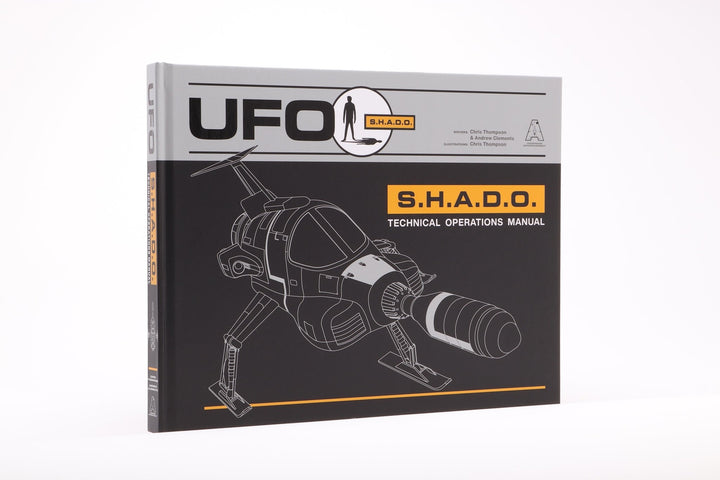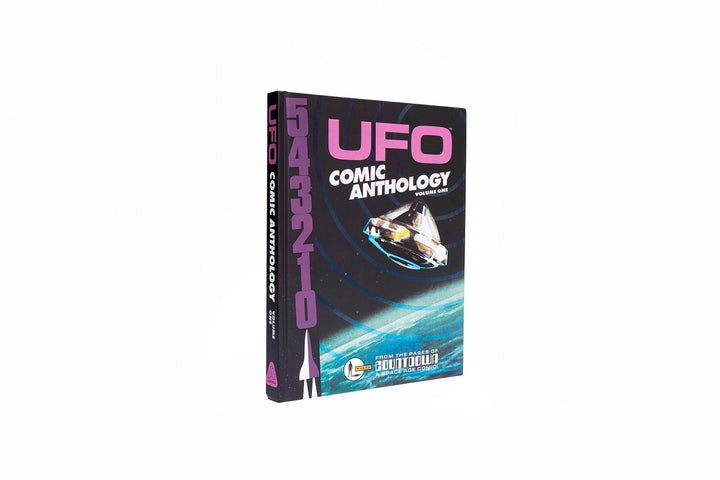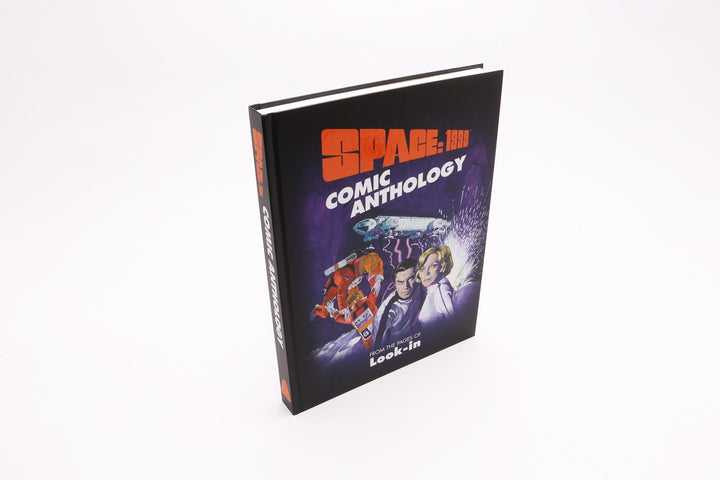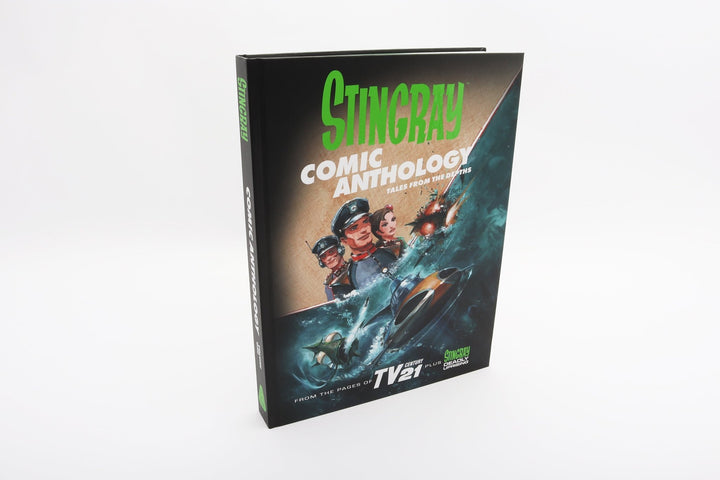
Throughout the 1980s and into the 1990s,
Thunderbirds fans would have occasionally found themselves faced with another television series also claiming to be an iteration of
Thunderbirds. While it certainly featured an organisation called International Rescue, a flotilla of futuristic rescue vehicles known as the Thunderbirds, and was even occasionally promoted using the same Thunderbirds logo as the original television show…it was clearly not of the same production stable as the classic Supermarionation series! Instead,
Thunderbirds 2086 was a Japanese animated series that had started life as a different show entirely, before being rebranded as a new incarnation of
Thunderbirds and then disappearing for good in the space of just over a decade!
Although very much a product of the 1980s the roots of the series can be traced back in 1977, to that post-
Space:1999 period where Gerry Anderson could no longer look forward to commissions from ITC (following Lew Grade reaching ITV’s mandatory retirement age and his decision to move into film production). Aware that his shows had always been very popular in Japan, he met with producer Banjiro Uemura looking to produce a new animated science fiction television series;
Thunderhawks.

Banjiro Uemura.
The idea for the series would undergo much revision (including a new title;
Terrahawks: Order to Recapture Earth) as various ideas were thrown around, but ultimately the project went nowhere due to the belief among Japanese networks that science fiction was no longer marketable. With the Japanese release of
Star Wars however came a sudden urgent need for science fiction on film and television - and one man was ready for it.
Uemura returned to the ideas he had devised while in consultation with Anderson and revised them into a concept that would essentially follow the format of
Thunderbirds (a series he enjoyed and had homaged in previous works) as closely as he dare. This was to be a twenty-four episode animated series by the name of
Kagaku Kyūjo Tai Tekunoboijā, or
Scientific Rescue Team Technoboyager. The series would follow the adventures of the agents of a futuristic global rescue service and their fleet of seventeen rescue vehicles, the Technoboyager craft.
https://www.youtube.com/watch?v=kXb7rOpeDsY
Unfortunately, the series was not a hit in Japan when it first aired in 1982, with only eighteen of its twenty-four episodes being broadcast. However, it was to find an afterlife thanks to Uemura’s connections at ITC. Presented with a ready-made series featuring various futuristic craft saving the day with the letters ‘TB’ (for Technoboyager) on their hulls, it was obvious that an English language dub could be produced that would capitalise on the already-established
Thunderbirds name – so obvious in fact that it may always have been Uemura’s plan to try to adapt the series in this way!
The 1983 English language version of
Technoboyager created by ITC America would be rechristened
Thunderbirds 2086, and the show’s characters would receive various re-namings and personality changes in this new version. The original opening and closing titles were also changed, with the new opening titles featuring narration that explained the purpose of the International Rescue organisation. This narration would sound familiar to anyone who had seen the trailers for the
Thunderbirds Super Space Theater compilations, both for sharing the same narrator and the immortal phrase
“conceptions in rescue that can challenge the impossible!” Several names associated with those
1980s compilation movies can be seen on the end credits of
2086, most notably editor Gunter Glinka, animator David Gregg, and producer Robert Mandell. Another link to the compilations, and the original Supermarionation series, was the
2086 redub’s use of additional music from the Barry Gray library, plus occasional bursts of Derek Wadsworth’s score for
Space:1999’s second season - as well as several sound effects, most notably the Moonbase Alpha travel tube sound on the opening titles.
https://www.youtube.com/watch?v=zowhg6l9RUc

The Arcology; headquarters of the new International Rescue.
Although the series featured the adventures of the Thunderbirds machines of International Rescue, it did not make any mention of the Tracy family or any other familiar element of the Supermarionation original - beyond a very occasional cry of
"Thunderbirds are Go!". Instead, the International Rescue of
Thunderbirds 2086 was a far larger organisation which operated out of a vast city known as the Arcology, built upon a manmade island. Although the organisation apparently employs hundreds of people, the main cast of heroes was limited to seven characters. The Thunderbirds machines would be manned by a group of captains (despite being called cadets during the opening titles narration) under the command of Doctor Warren Simpson,
2086’s equivalent of Jeff Tracy. The Thunderbird 1 space shuttle was piloted by daring young hotshot Dylan Beyda, while the hypersonic transport Thunderbird 2 was co-piloted by would-be space cowboy Jesse Rigel and Jonathan ‘Little John’ Jordan, Jnr. Thunderbird 3, a multi-purpose ground vehicle, would be commanded by Gran Hanson – who also served as the team’s leader for most missions. Thunderbirds 1 2 and 3 could also combine to ensure maximum preparedness for any emergency situation. The sole female member of the team, Kallan James, was in charge of International Rescue’s primary underwater craft, Thunderbird 4. Rounding out the regular cast – whether you liked it or not – was Commander Simpson’s seven-year-old nephew ‘Skipper’.

Doctor Simpson briefs the Thunderbirds team. L-R; Dylan Beyda, Kallan James, Jesse Rigel, ‘Little John’ and Gran Hanson.
The number of Thunderbirds machines in this new International Rescue was also increased from six to seventeen (with an eighteenth under construction in the episode
Starcrusher), although several would never appear on screen. Most were substantially different from those seen in the Supermarionation series, although several borrowed heavily from those designs. Thunderbird 4 would remain a yellow submarine, while Thunderbird 16 was a gold and silver drilling machine named the Mole. Thunderbird 6 was the organisation’s Earth-orbiting space station, but manned by a crew of hundreds as opposed to one.

"Who do I speak to about a transfer?"

2086's Thunderbird 4.
Thunderbirds 2086 made greater use of science fiction concepts and space travel in general than the original Supermarionation series, although its vehicles were designed with more of a functional appearance than those seen there. By and large the English redub followed the stories of the original Japanese episodes but its tone was often very tongue-in-cheek, and it wasn’t afraid to make references to other television shows and films. This was a world where evil computers would claim to control
“the horizontal and the vertical”, where a convicted man would yell
“I am not a number, I am a free man!” upon being sentenced, where a cynical astronaut would announce
“I’ve never seen anything to make me believe there’s some mystical energy controlling my destiny!” short before encountering said Force (and then crying
“I do believe in ghosts, I do believe in ghosts!”), and where absolutely all engineers were Scottish. The humour threatens to finally break the fourth wall completely at the start of the final episode,
UFO, where the captain of a sailing vessel gets excited about his first appearance on television;
CAPTAIN:
"I say, old bean! Here we are beginning our story, our adventure into outer space. I can’t wait to see what happens to us!"
MATE:
"We’re not in this story!"
CAPTAIN: "What?"
And then their ship is promptly flattened by a tidal wave.

"I say, old bean! Now here we are on a website. I can't wait to see how many comments we get!"

Kudzilla's creator; eaten alive here in the Japanese original, 'thrown clear' in the 2086 redub.
In keeping with the sanitised nature of many English dubs of Japanese animated shows, death was something the
2086 redub tried to avoid mentioning wherever possible, with various clearly dead characters described as being
“unconscious” or announcing from off-screen that they
“ejected just in time!” without any visual evidence around the wreckage of their vehicle to back that claim up. Occasionally episodes would even be reworked to remove objectionable scenes entirely, most notably
Child’s Play which opens with an extensive clips montage of the International Rescue vehicles in action in order to fill time left by the deletion of a problematic subplot from the second half of the Japanese original. In the episode
Kudzilla two brand new shots were animated (either by the original animators or by some very talented imitators) to allow a character who died in the Japanese original to live in the Western redub. Other animation changes were less drastic, and included the addition of more blinking lights on control consoles and occasional insert shots of computer screens displaying useful plot information.

Like so.
One additional element that came into play midway through
Thunderbirds 2086’s run came with the arrival of the mysterious villain Star Crusher and his terrorist group the Shadow Axis, who were behind nefarious plots in several episodes. Although not part of the original
Technoboyager series it was nevertheless an interesting attempt to provide a regular villain for
2086 through voiceover alone, since the original animation could not be altered enough to incorporate a new animated character.

The 'IRO datacube'.
The Star Crusher dialogue sequences (usually backed by Barry Gray music traditionally heard in association with the Mysterons) would often play out over the same electronic space footage created by Dolphin Productions for the two
Captain Scarlet Super Space Theater compilations, as would sequences involving another
2086 addition; the IRO Datacube. Generally running to around seventy seconds, these ‘datacube’ segments would feature a briefing from the same voice artist who narrated the show’s opening titles in which he explained the plot of that week’s episode before it actually started. It’s difficult to see what purpose this sequence actually served, beyond possibly padding out the episode for a thirty-minute broadcast slot, and certain episodes currently circulating online can be found both with and without this sequence – but most of them are without!

Japanese soundtrack album.
Thunderbirds 2086 played in several international markets, including the UK, Spain, Malaysia, Italy, Portugal, Australia and Canada, but very few countries ran the entire series. In the UK a batch of thirteen episodes were broadcast on BBC 1, first in a Monday afternoon slot beginning in January 1986 and then again as part of Saturday morning series
Going Live from January 1988. The series received very little in the way of merchandise in either of its incarnations. In Japan, toys of Technoboyagers 1 2 and 3 apparently never made it past the prototype stage, but fans of the show’s soundtrack could pick up a pair of vinyl records (a 7” and a 12”). Oddly,
Thunderbirds 2086 would would earn itself a hardback annual, which was published in the UK by Grandreams in 1983 – more than two years before the series would actually air on British television!

Original 1986 VHS release.
The series fared slightly better in the home media department. At least two two-episode VHS tapes were released in both the USA and Spain, and two different two-episode VHS tapes were also released in the UK in the late 1980s, although unfortunately with the same episode included twice;
Cloudburst & Nightmare was released by The Video Collection in 1986, while
Nightmare & Metalhead was released by Lollipop in 1989. When the nation was gripped by
Thunderbirds mania in 1991 ITC Home Video attempted to revive
Thunderbirds 2086, this time releasing sixteen episodes of the series across three VHS tapes – with volumes two and three sporting the classic
Thunderbirds logo in a bid to attract new viewers! Altogether, seventeen of
2086's twenty-four episodes found their way to VHS in the UK, but the remaining seven have currently yet to receive any official release – as the series has not yet been released on DVD. It currently circulates online only thanks to the VHS releases and various off-air recordings.
While
Technoboyager has been released complete on DVD in Japan (although it’s not cheap!)
Thunderbirds 2086 seems to have fallen in a home media void - perhaps deliberately so? While it may have made sense back in the 1980s and early 1990s to closely associate the anime with its Supermarionation forebear in order to help sell it, the original
Thunderbirds has continued to remain in the public consciousness more than fifty years after it first aired. In the UK alone the Supermarionation television series has been revived more than once since
2086 was last broadcast, to continued public interest and acclaim, and crucially does not look like a product of the 1960s.
Thunderbirds 2086 however
does look very 1980s, and there may be someone somewhere looking to quietly bury it lest it reflect badly on the lucrative
Thunderbirds brand. Additionally, the series has always proved very polarising among
Thunderbirds fans. Some appreciate a radical ‘alternate universe’ style take on the
Thunderbirds format, while others see it as an abomination and their hatred for it is such that no amount of four-letter words can do it justice. Thanks to the show’s lack of repeats however, many simply don’t even know that it ever existed at all.

While not exactly beloved by
Thunderbirds fans generally it’s important to remember that
2086 was originally a different series in its own right before it got rebranded with the
Thunderbirds name, and although that rebranding may always have been in the mind of the show’s creator the entire series was inspired by his love for the original
Thunderbirds. That love was the catalyst for
Technoboyager, which was then realised by a lot of talented artists and technicians who also believed in the idea. While the English dubbing on
2086 can at times be a little clunky the show often looks very nice, and tells sci-fi stories that the original
Thunderbirds would never even consider attempting alongside the more traditional rescue tales. Both versions also boast a beautiful orchestral soundtrack composed by Kentaro Haneda that veers from Seventies disco to concert-level piano work with surprising gracefulness. There’s a lot here to like if you’re in the mood for a slightly wackier, more science-fiction-oriented, and occasionally scarier take on
Thunderbirds, but it’s understandable that the series is maybe just too different from the original to be to everyone’s tastes - particularly if anime isn't your thing.
Crucially, the existence of
Thunderbirds 2086 takes nothing away from the 1965 Supermarionation original, and there are many who saw the show back in the 1980s (or who received a VHS from Grandma in the early 1990s who bought it thinking it was the 1960s puppet series!) that would appreciate the chance to see it again on DVD. In a world where any number of woeful sitcoms or no-budget cash-in movies can get a DVD release, then surely
Thunderbirds 2086 also deserves a shot?
Right?

 Throughout the 1980s and into the 1990s, Thunderbirds fans would have occasionally found themselves faced with another television series also claiming to be an iteration of Thunderbirds. While it certainly featured an organisation called International Rescue, a flotilla of futuristic rescue vehicles known as the Thunderbirds, and was even occasionally promoted using the same Thunderbirds logo as the original television show…it was clearly not of the same production stable as the classic Supermarionation series! Instead, Thunderbirds 2086 was a Japanese animated series that had started life as a different show entirely, before being rebranded as a new incarnation of Thunderbirds and then disappearing for good in the space of just over a decade!
Although very much a product of the 1980s the roots of the series can be traced back in 1977, to that post-Space:1999 period where Gerry Anderson could no longer look forward to commissions from ITC (following Lew Grade reaching ITV’s mandatory retirement age and his decision to move into film production). Aware that his shows had always been very popular in Japan, he met with producer Banjiro Uemura looking to produce a new animated science fiction television series; Thunderhawks.
Throughout the 1980s and into the 1990s, Thunderbirds fans would have occasionally found themselves faced with another television series also claiming to be an iteration of Thunderbirds. While it certainly featured an organisation called International Rescue, a flotilla of futuristic rescue vehicles known as the Thunderbirds, and was even occasionally promoted using the same Thunderbirds logo as the original television show…it was clearly not of the same production stable as the classic Supermarionation series! Instead, Thunderbirds 2086 was a Japanese animated series that had started life as a different show entirely, before being rebranded as a new incarnation of Thunderbirds and then disappearing for good in the space of just over a decade!
Although very much a product of the 1980s the roots of the series can be traced back in 1977, to that post-Space:1999 period where Gerry Anderson could no longer look forward to commissions from ITC (following Lew Grade reaching ITV’s mandatory retirement age and his decision to move into film production). Aware that his shows had always been very popular in Japan, he met with producer Banjiro Uemura looking to produce a new animated science fiction television series; Thunderhawks.
 Banjiro Uemura.
Banjiro Uemura. The Arcology; headquarters of the new International Rescue.
The Arcology; headquarters of the new International Rescue. Doctor Simpson briefs the Thunderbirds team. L-R; Dylan Beyda, Kallan James, Jesse Rigel, ‘Little John’ and Gran Hanson.
Doctor Simpson briefs the Thunderbirds team. L-R; Dylan Beyda, Kallan James, Jesse Rigel, ‘Little John’ and Gran Hanson. "Who do I speak to about a transfer?"
"Who do I speak to about a transfer?" 2086's Thunderbird 4.
2086's Thunderbird 4. "I say, old bean! Now here we are on a website. I can't wait to see how many comments we get!"
"I say, old bean! Now here we are on a website. I can't wait to see how many comments we get!" Kudzilla's creator; eaten alive here in the Japanese original, 'thrown clear' in the 2086 redub.
Kudzilla's creator; eaten alive here in the Japanese original, 'thrown clear' in the 2086 redub. Like so.
Like so. The 'IRO datacube'.
The 'IRO datacube'. Japanese soundtrack album.
Japanese soundtrack album. Original 1986 VHS release.
Original 1986 VHS release. While not exactly beloved by Thunderbirds fans generally it’s important to remember that 2086 was originally a different series in its own right before it got rebranded with the Thunderbirds name, and although that rebranding may always have been in the mind of the show’s creator the entire series was inspired by his love for the original Thunderbirds. That love was the catalyst for Technoboyager, which was then realised by a lot of talented artists and technicians who also believed in the idea. While the English dubbing on 2086 can at times be a little clunky the show often looks very nice, and tells sci-fi stories that the original Thunderbirds would never even consider attempting alongside the more traditional rescue tales. Both versions also boast a beautiful orchestral soundtrack composed by Kentaro Haneda that veers from Seventies disco to concert-level piano work with surprising gracefulness. There’s a lot here to like if you’re in the mood for a slightly wackier, more science-fiction-oriented, and occasionally scarier take on Thunderbirds, but it’s understandable that the series is maybe just too different from the original to be to everyone’s tastes - particularly if anime isn't your thing.
Crucially, the existence of Thunderbirds 2086 takes nothing away from the 1965 Supermarionation original, and there are many who saw the show back in the 1980s (or who received a VHS from Grandma in the early 1990s who bought it thinking it was the 1960s puppet series!) that would appreciate the chance to see it again on DVD. In a world where any number of woeful sitcoms or no-budget cash-in movies can get a DVD release, then surely Thunderbirds 2086 also deserves a shot?
Right?
While not exactly beloved by Thunderbirds fans generally it’s important to remember that 2086 was originally a different series in its own right before it got rebranded with the Thunderbirds name, and although that rebranding may always have been in the mind of the show’s creator the entire series was inspired by his love for the original Thunderbirds. That love was the catalyst for Technoboyager, which was then realised by a lot of talented artists and technicians who also believed in the idea. While the English dubbing on 2086 can at times be a little clunky the show often looks very nice, and tells sci-fi stories that the original Thunderbirds would never even consider attempting alongside the more traditional rescue tales. Both versions also boast a beautiful orchestral soundtrack composed by Kentaro Haneda that veers from Seventies disco to concert-level piano work with surprising gracefulness. There’s a lot here to like if you’re in the mood for a slightly wackier, more science-fiction-oriented, and occasionally scarier take on Thunderbirds, but it’s understandable that the series is maybe just too different from the original to be to everyone’s tastes - particularly if anime isn't your thing.
Crucially, the existence of Thunderbirds 2086 takes nothing away from the 1965 Supermarionation original, and there are many who saw the show back in the 1980s (or who received a VHS from Grandma in the early 1990s who bought it thinking it was the 1960s puppet series!) that would appreciate the chance to see it again on DVD. In a world where any number of woeful sitcoms or no-budget cash-in movies can get a DVD release, then surely Thunderbirds 2086 also deserves a shot?
Right?




![Fireball XL5 World Space Patrol Technical Operations Manual [HARDCOVER BOOK] - The Gerry Anderson Store](http://gerryanderson.com/cdn/shop/files/fireball-xl5-world-space-patrol-technical-operations-manual-hardcover-book-290050.jpg?v=1711729272&width=720)



![Stingray Comic Anthology Volume Two – Battle Lines [HARDCOVER] - The Gerry Anderson Store](http://gerryanderson.com/cdn/shop/files/stingray-comic-anthology-volume-two-battle-lines-hardcover-107681.jpg?v=1738856151&width=720)
![Space: 1999 and UFO Book Bundle - Signed Limited Editions [HARDCOVER NOVELS] - The Gerry Anderson Store](http://gerryanderson.com/cdn/shop/files/space-1999-and-ufo-book-bundle-signed-limited-editions-hardcover-novels-589446.jpg?v=1718836845&width=720)
![Stingray WASP Technical Operations Manual Special Limited Edition [HARDCOVER BOOK] - The Gerry Anderson Store](http://gerryanderson.com/cdn/shop/files/stingray-wasp-technical-operations-manual-special-limited-edition-hardcover-book-991914.jpg?v=1732922875&width=720)
![Stingray: The Titanican Stratagem – Signed Limited Edition [HARDCOVER NOVEL] - The Gerry Anderson Store](http://gerryanderson.com/cdn/shop/files/stingray-the-titanican-stratagem-signed-limited-edition-hardcover-novel-129251.jpg?v=1740558711&width=720)







1 comment
As kids in the ‘80s, we were surprised to learn (via a newspaper, I think) that Thunderbirds 2086 had in fact not originated with Gerry Anderson. Despite using cel animation, (excellent animation by the way!), instead of marionettes, this series seemed like the ultimate affirmation of Gerry’s original Thunderbirds; the primary International Rescue team had done such an amazing job, that by twenty years later, they had inspired a massive, all-encompassing and new International Rescue organisation. A ringing endorsement! We were too young to understand the negativity around the show. As far as we were (and are) concerned, Thunderbirds 2086 was exceptional entertainment!
I wonder if maybe Anderson Entertainment might one day commit these twenty-four additional Thunderbirds episodes to disc for us ‘80s kids to enjoy again! After all, it was an ITC show just like most of Gerry’s programs, and it wouldn’t be the first time the Anderson shop has given us a related-to-but-not-quite-a-Gerry-Anderson-show on disc. I’ll be forever grateful for the release of Space Patrol! ;-)
In fact, it could lead to an Anderson “imprint” so to speak of merchandise based on Thunderbirds 2086, Space Patrol, and maybe The Champions.
And besides, you know all the modern kids love Japanese cartoons. Let’s give them the undiscovered treasure that is THUNDERBIRDS 2086!